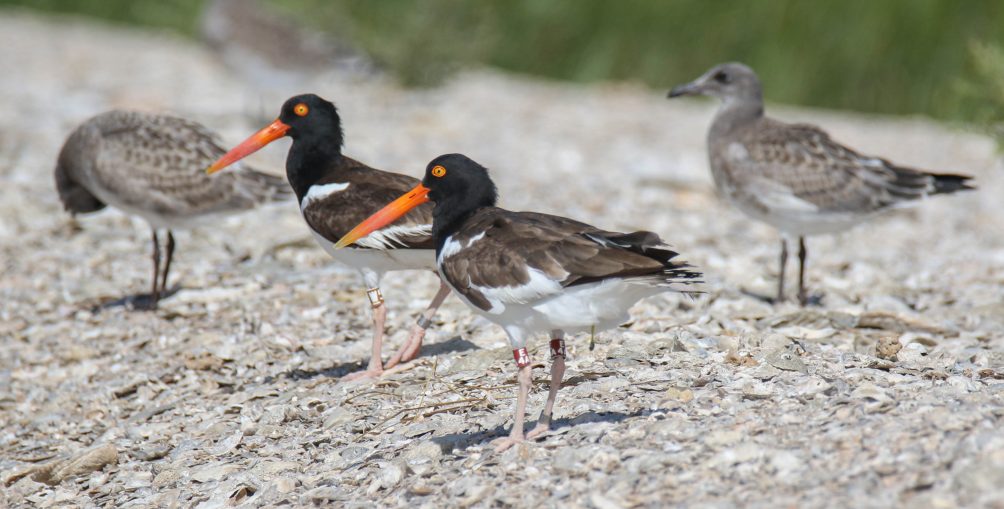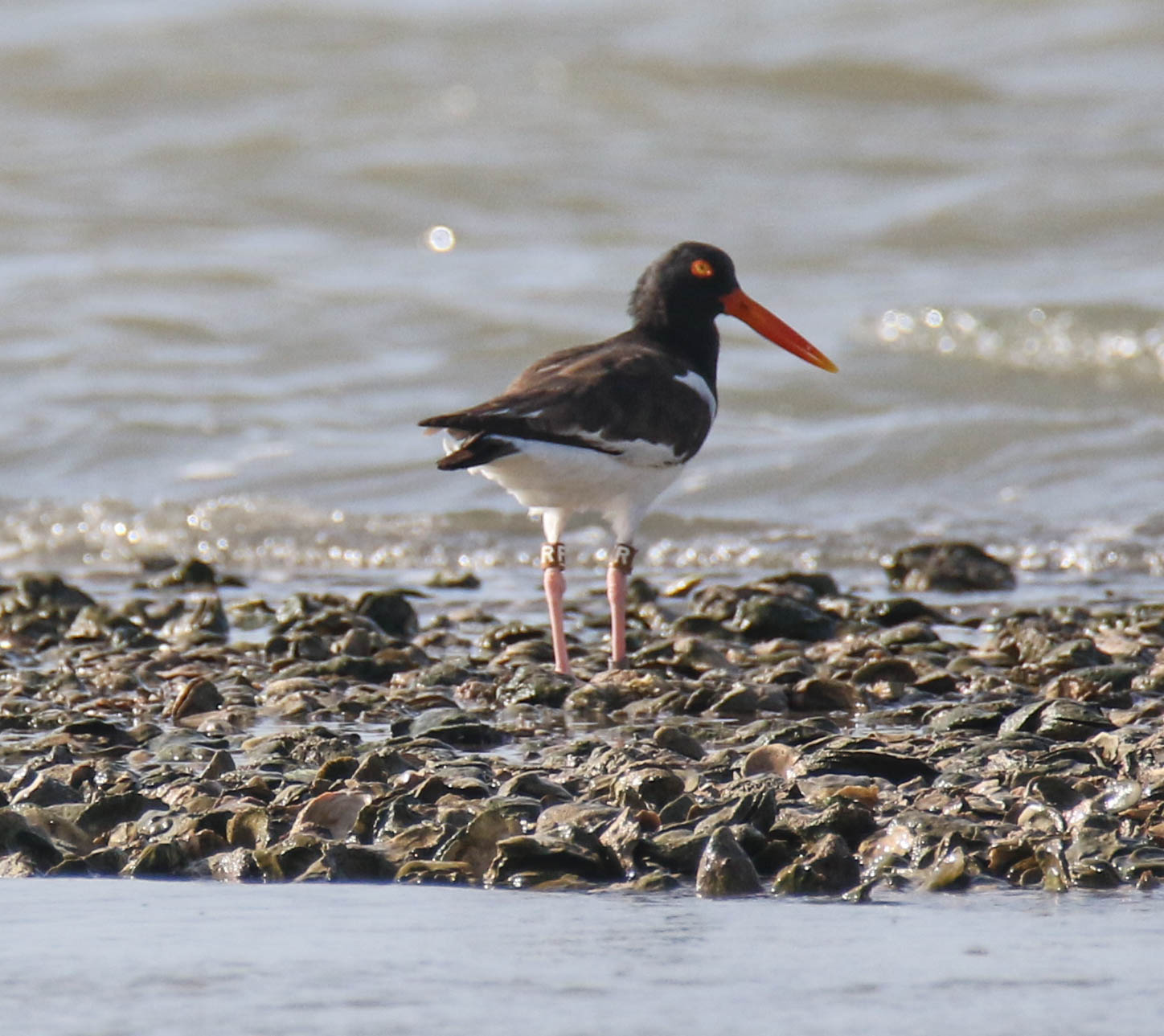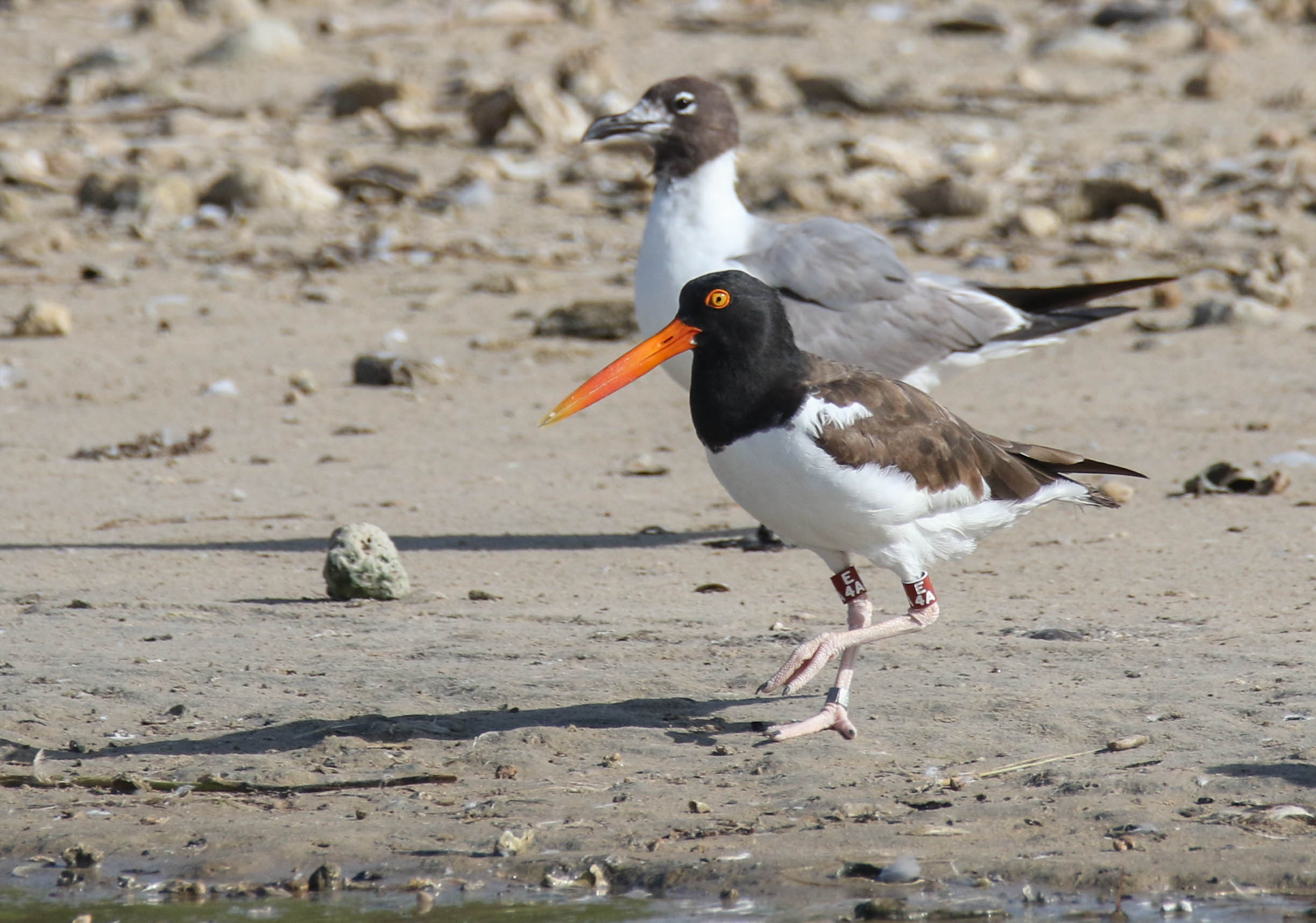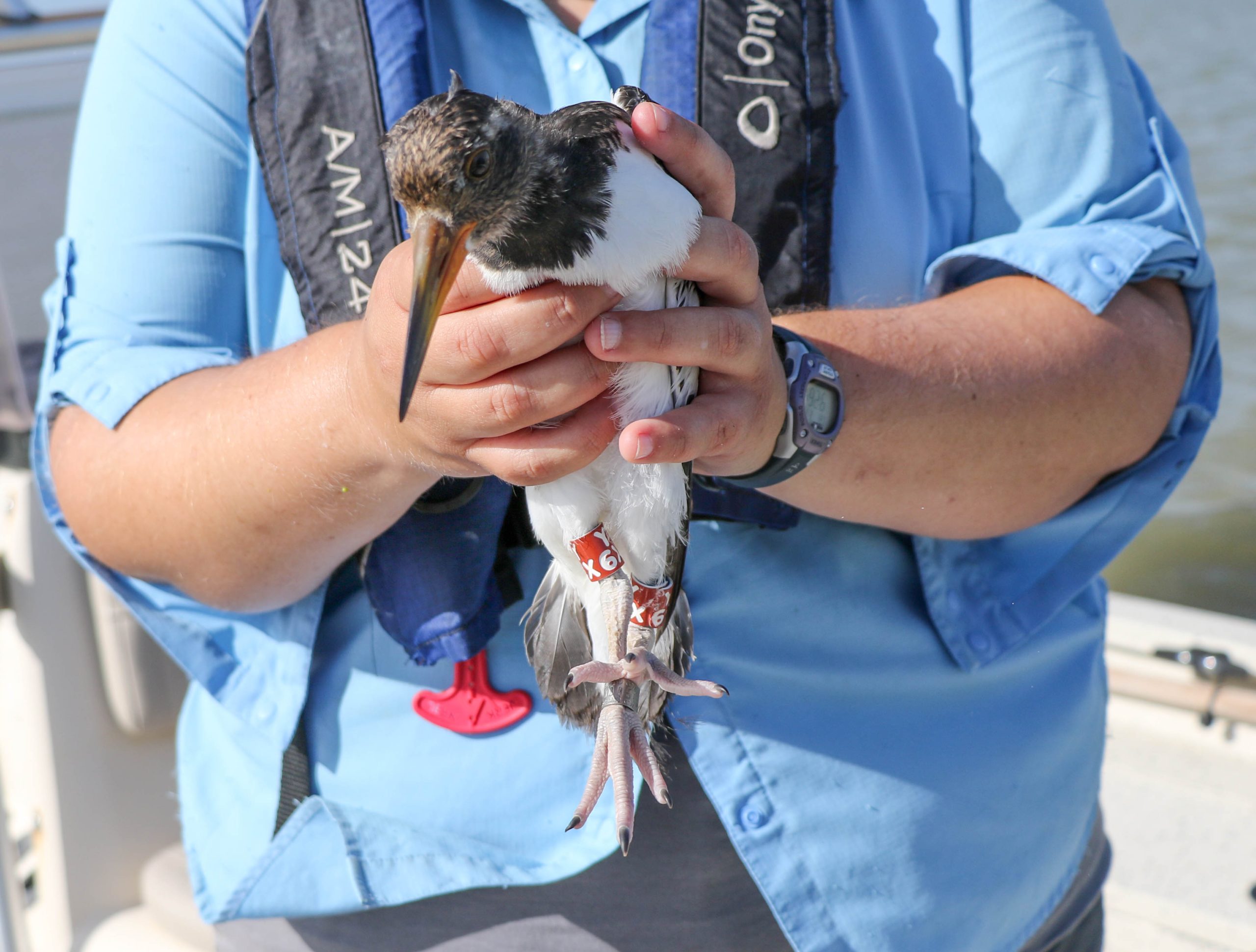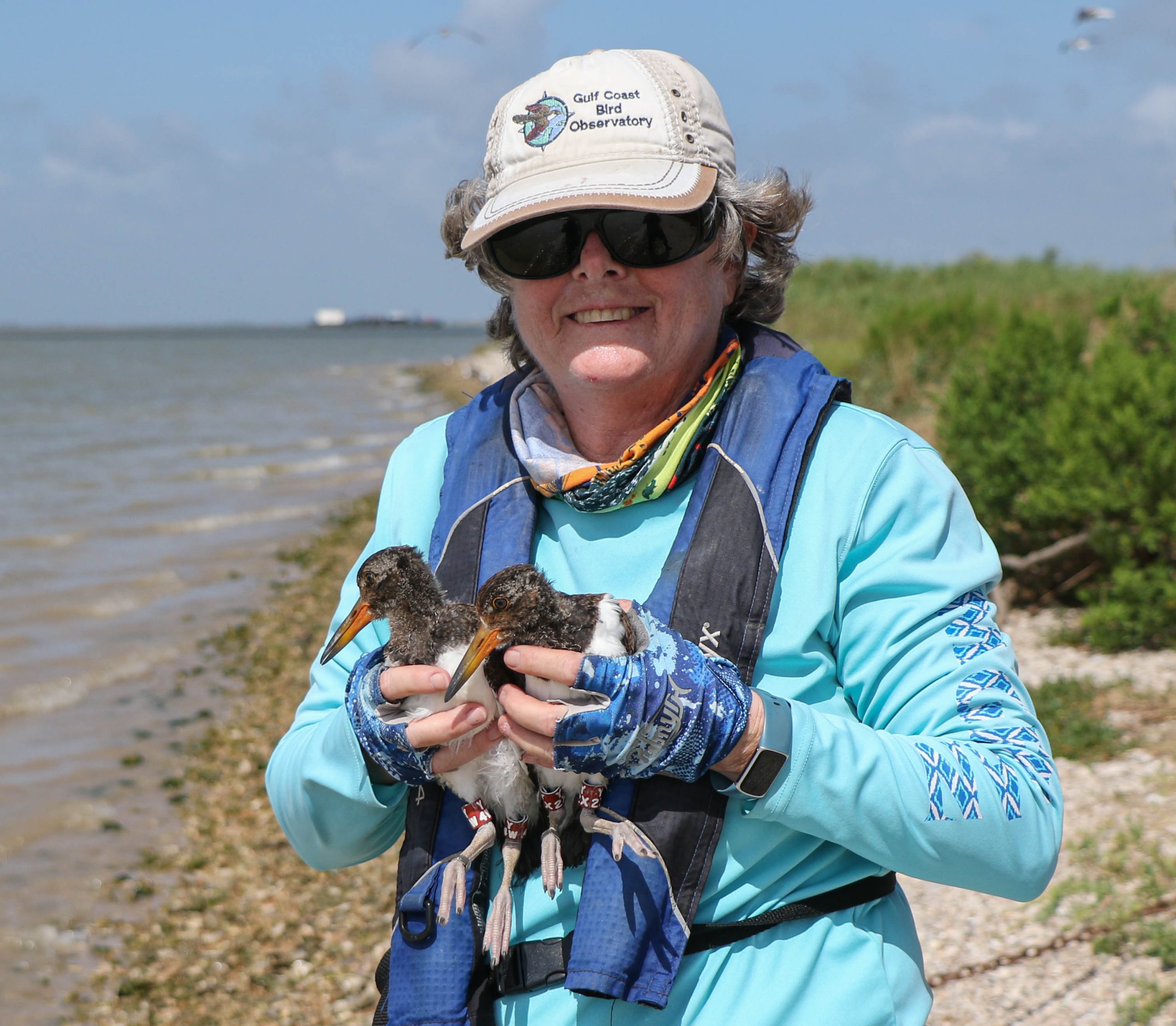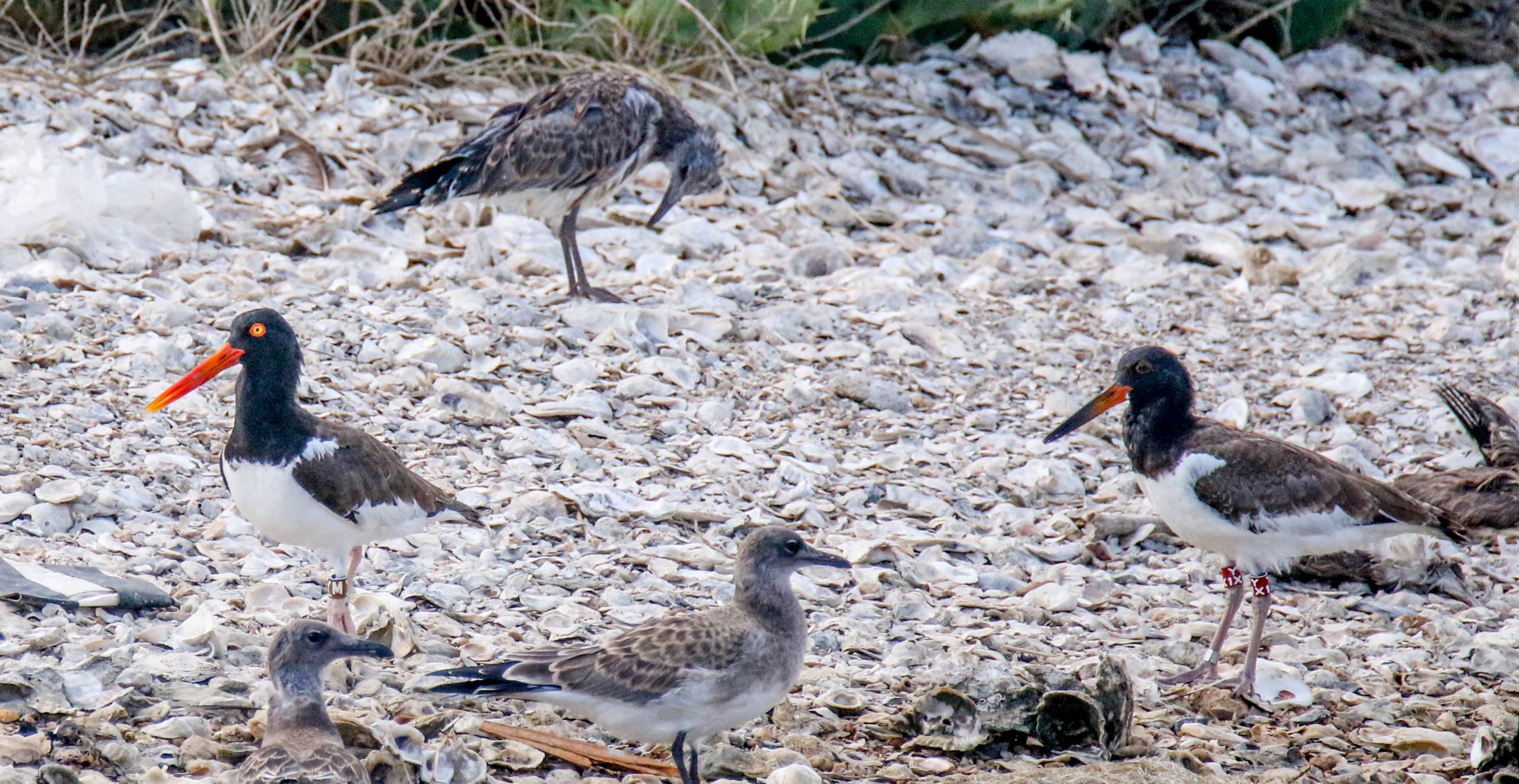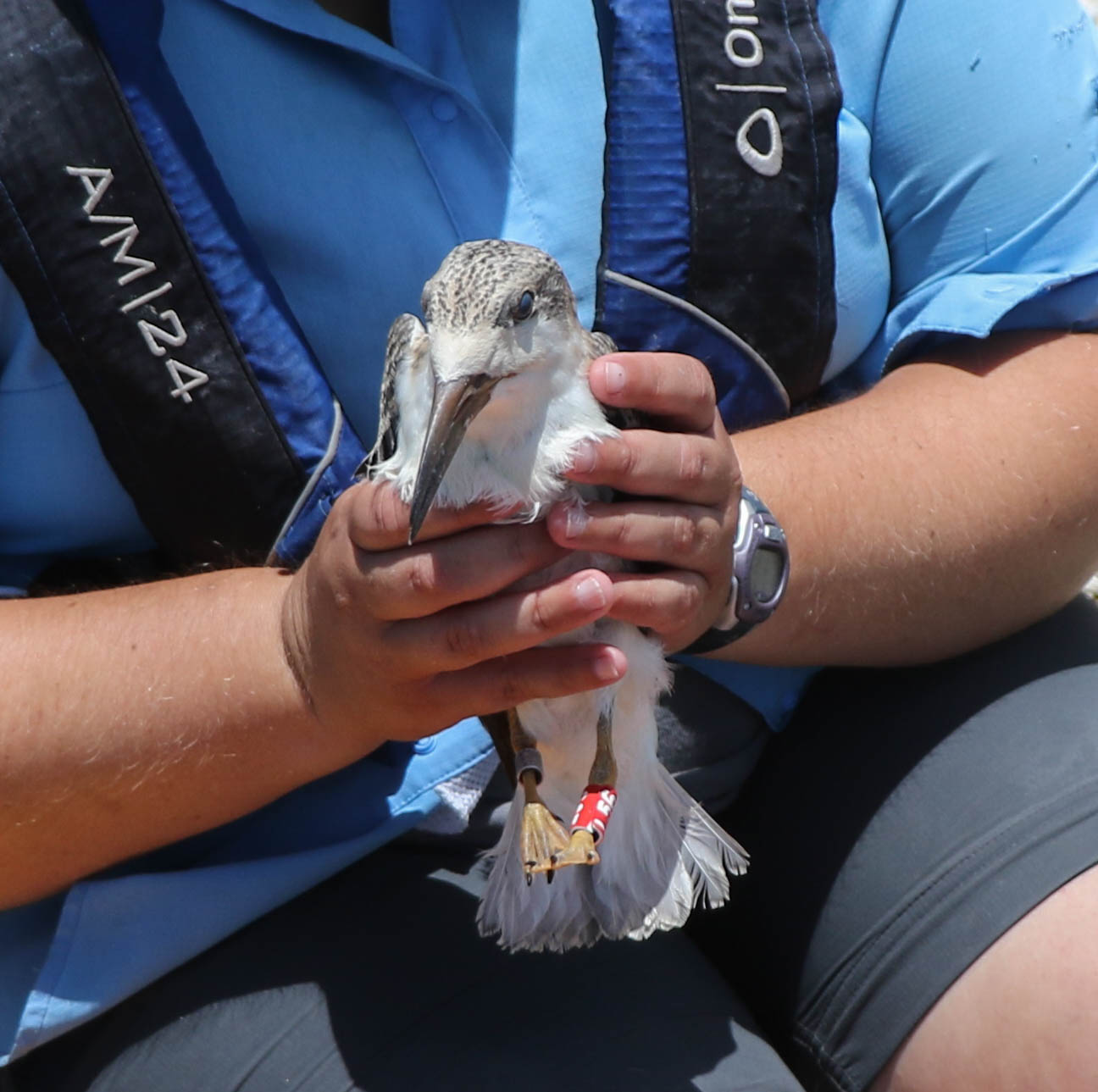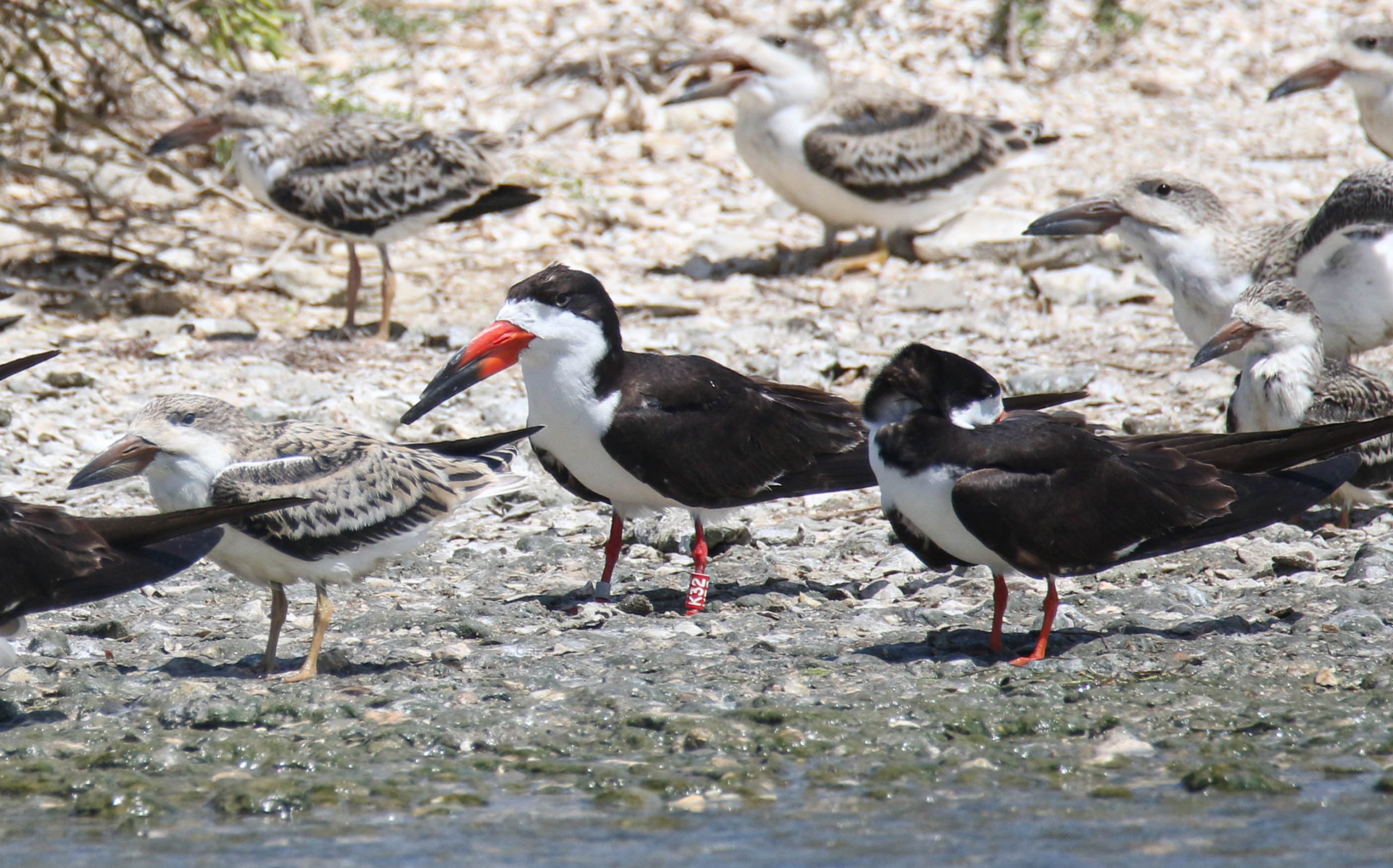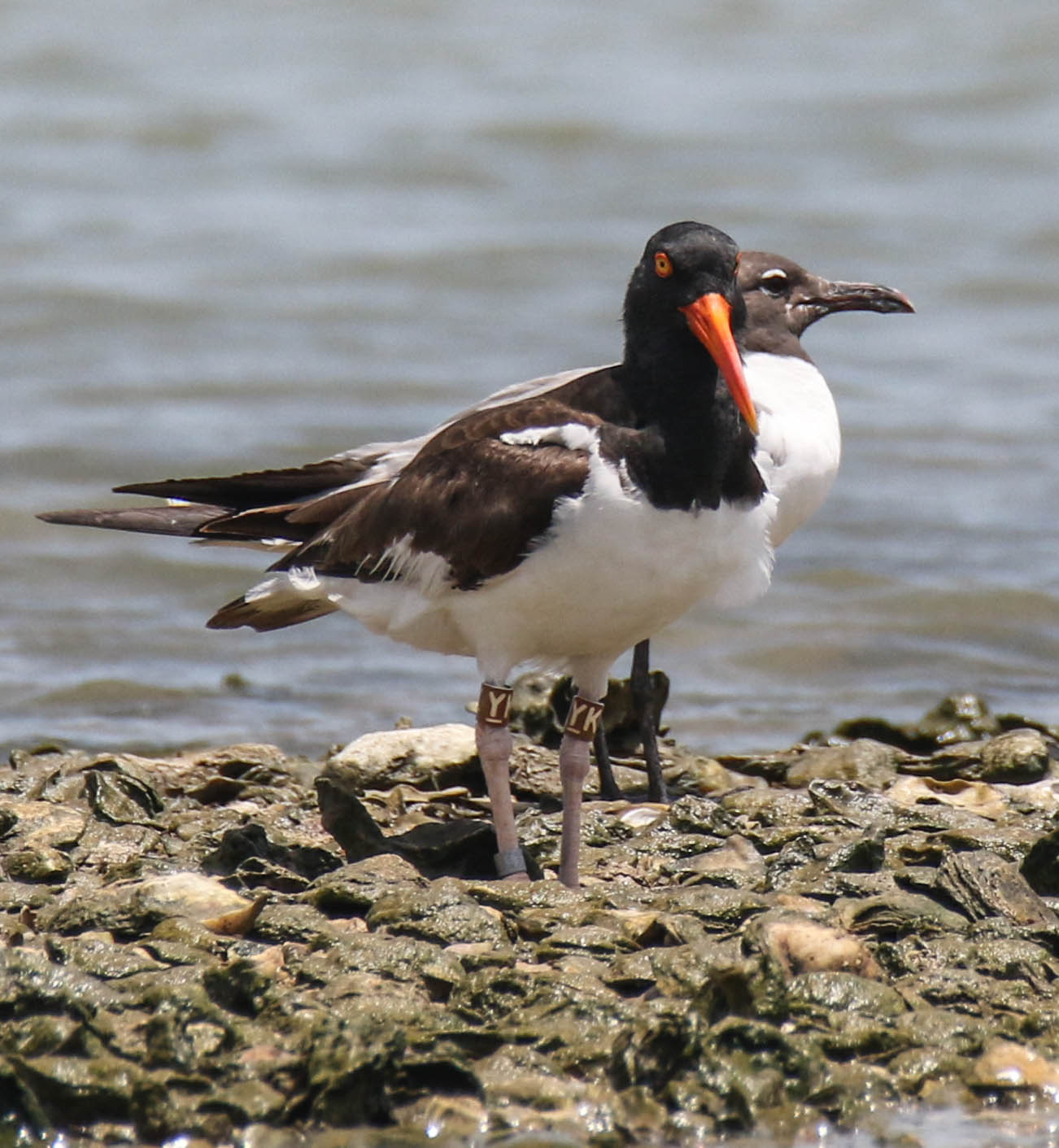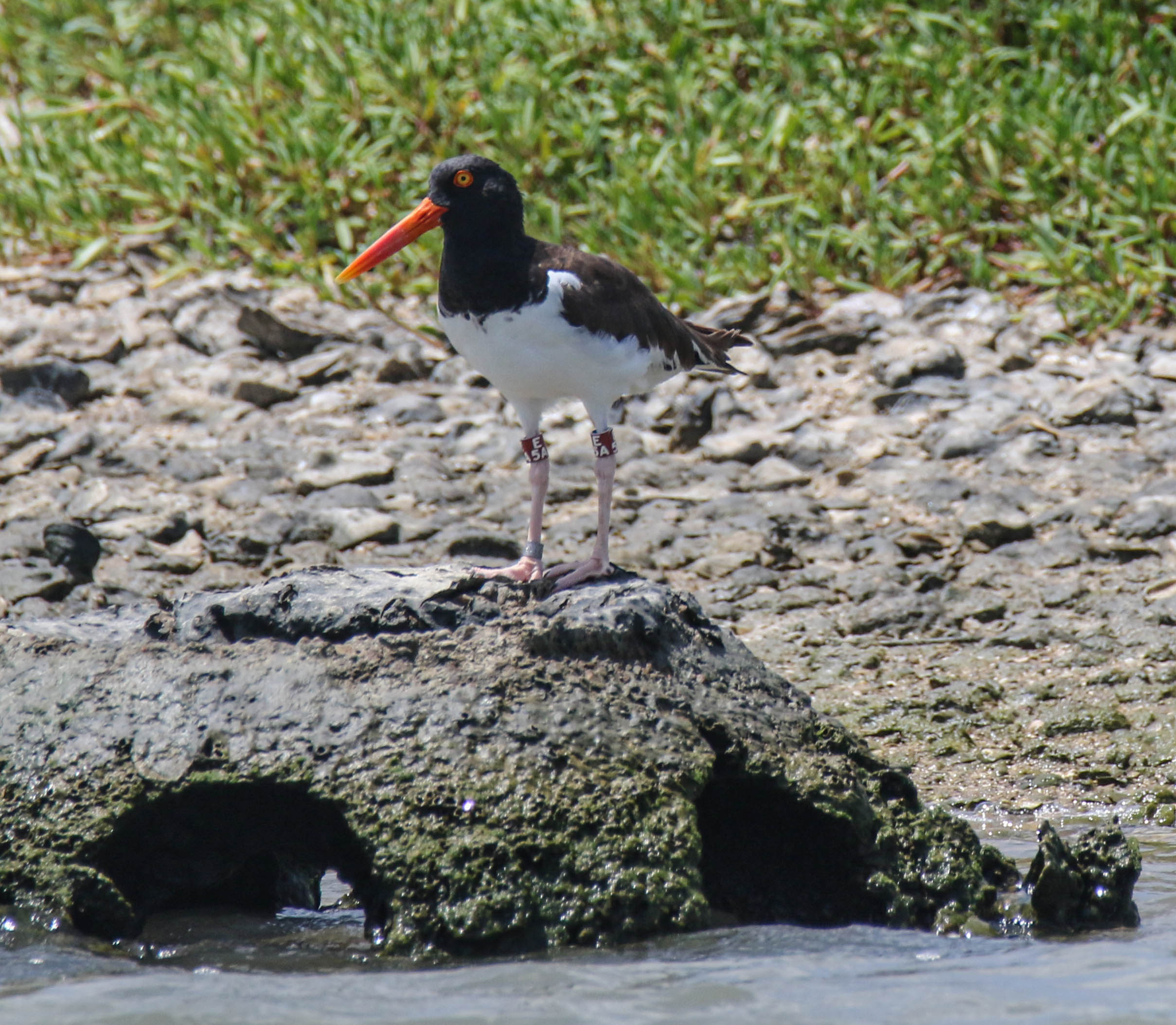By Rebecca Bracken
On Wednesday, Sue, Ashley Van Wieren (our new education intern!) and I went out to East Matagorda Bay to count skimmers and check on 25’s chicks. It was a bit choppy out there, but thankfully we didn’t have to go too far. The skimmers are doing great – many chicks of varying ages scattered between the three islands we check.
25 and his mate were on their island, but we initially didn’t see the chicks. We decided to beach the boat and take a closer look, just to make sure all was ok. Sue found both chicks hiding along the shoreline. It’s amazing how well they can blend in given the changes in color between wet and dry oyster shells! We’ll be back in two weeks to band them.
On Thursday, Sue, Alan Wilde, Elena Duran, and I went out to West Galveston Bay. We had a huge day planned – we needed to band three oystercatcher chicks and twenty skimmer chicks, plus check on as many pairs as we could. We did our journey in reverse order, by starting in Jones Bay with CA and Y2 and then to FR and family.
Sue spotted CA and Y2’s chick from a distance, but of course as we got closer it disappeared. But one of the adults was there, and that chick has been fledged for quite a while now, so we weren’t worried. FR and unbanded’s spat must have boiled over, because he was there with both chicks but she was nowhere to be found! Taking care of chicks is tiring work; hopefully she was a getting a well-deserved break.
From there, we motored quickly past JC and W5’s and E4A and unbanded’s territories on Marker 52 to look for their chicks before banding them. We knew that each had at least one chick, but we really hoped we would see more before going and searching for them. They’re such good hiders that it’s always easier if we know how many chicks to look for! We saw two chicks with JC and W5 and one chick with E4A and unbanded.
We started by finding E4A and unbanded’s chick. By the time we got out of the boat, it was nowhere to be found! It ran and hid somewhere, and it took quite a bit of searching to find it. I eventually found it hidden under a bush right next to a pelican egg. It was promptly banded Y6X, and released back to its waiting parents.
We turned around to go back to W5 and JC’s territory and suddenly they weren’t there! We went and looked where we last saw them, but couldn’t even find the adults. Alan walked to the other side of the island while Sue, Elena, and I moved the boat around. They didn’t seem to be there either, but we looked up and they were back on the first side. So sneaky! We quickly motored back to their original spot where both adults and both chicks were hanging out on the shoreline. They must have been very confused why we were back so soon because the chicks didn’t run and hide until we were almost upon them! One chick ran behind a bush to hide while the other took off down the beach. But we quickly caught them and gave them their bands Y2X and Y4W.
After giving the chicks back to their parents, we started to check on the other pairs in the area. JJ wasn’t home but P4 was. UF and JC were with their chick on one of the small islands off of Marker 52. I completely forget to mention last week that their chick fledged! We saw it flying around behind the parents last week. On North Deer, YM and JH were on the shoreline with their chick as usual, but C1A and E8A weren’t home. On South Deer, only E2A was home.
Then it was time to head to Gangs Bayou to count skimmers and band chicks. We pulled up on the island and got ready to corral the chicks. We were able to catch 20 chicks to band. Sue and I banded them, and then Alan and I helped Elena get her samples collected.
Alan also got some great pictures of the banded adult skimmers.
While Elena and I were working, we felt and heard a large rumble, almost like thunder. But we knew there wasn’t a chance of rain that day, so we were really confused. I looked up and immediately saw a large explosion fire happening at what appeared to be one of the chemical plants on the Brazoria side of the bay. Sue and Alan also were watching it through binoculars from the boat, just to make we weren’t going to have any issues going home. You’ve probably already heard about this fire; a pipeline near the INEOS plant exploded and caused a massive fireball. It was amazing that we could still hear and feel it from so far away. Thankfully no one was injured by the explosion.
After we finished up at Gangs, we were all pretty tired. We went looking for birds along Galveston Island and 8 Mile Road and found a few youngsters and YK. No one was home at Jigsaw.
Over at Struve, we anchored and counted skimmers. It seems like many of the Struve skimmers are moving to Gangs Bayou, but for some reason one of the chicks we banded a few weeks ago at Gangs is now hanging out at Struve! Great to know it successfully fledged, but the Struve birds don’t seem to like having it around. All the oystercatcher pairs were home. LT and JA were loafing around at the end of the island while HM and X7 were on the shoreline at the opposite end. 12 and unbanded were on their territory, and E5A was posing nicely for us.
After we finished at Struve, we were all exhausted and it was getting late. We decided to call it a day and save Swan Lake for next week. I’m sure 11 and family enjoyed the break from us, but we can’t wait to see their chicks again next week.
If you like oystercatchers and you want to support this project, you can make a donation (thank you!) on our website here. And how could anyone not like oystercatchers!
Current Stats for upper Texas coast from Dickinson Bay to East Matagorda Bay: 0 nests being incubated, 31 failed nests, 3 nests with unfledged chicks, 0 nests with undetermined status, 25 chicks fledged
Note: All trapping and banding for this project is in accordance with federal and state permits issued to Susan Heath, GCBO Director of Conservation Research. Bird handling by volunteers is only permitted in the presence of Susan Heath and volunteers are trained in proper bird handling techniques.

